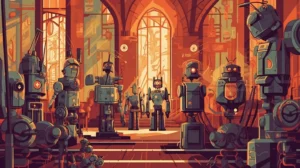
Once upon a time, in a valley far, far away, lived a passionate young entrepreneur.
The entrepreneur wanted to change the world. He wanted to do something with his life that would truly make a difference. A true mission.
Having coffee with a close friend named Phil, the entrepreneur blurted out: “People are not connected anymore. I want to help. Tech will solve it. What if I build a global digital platform in the cloud that truly connects people with other people. It will completely disrupt the way we connect with people. It will change the world!” The entrepreneur shot up out of his chair in excitement, ran out the door, and got to work.
He began reading every book on tech startups he could find: The Lean Startup, Sprint, Hooked, Startup Land, The Innovator’s Dilemma, The Startup Owner’s Manual, and of course, Elon Musk: Tesla, PayPal, SpaceX, and the Quest for a Fantastic Future.
He Youtube searched: “how to build a successful tech startup” He watched countless hours of videos: “How To Build The Next Billion Dollar Startup,” “The Single Biggest Reason Why Start-ups Succeed,” and of course, every episode of “Shark Tank.”
And he started learning the tech lingo: pivot, venture capital, dongle, unicorn, UI/UX, big data, shadowban, scale up, runway, biohacking, move fast and break things, IPO, FAANG, and autopilot.
He was ready.

He built an mvp. Took it to market. Got users. Organic growth ensued. He hired his first interns.
The startup grew. And quickly.
He applied for every one of the most popular accelerators on the planet: Y Combinator, TechStars, 500 Startups, Venture Catalysts, and GAN.
He received pre-seed funding. Only a few more rounds to go (Seed, Series A, Series B, Series C). He was one step closer to changing the world, a goal that was now fading from memory.
He spent less and less time thinking about the heart behind the company and more and more time discussing ways to get more users to get more funders to make more money to sell the company.
He got his first business card.
“CEO and Founder.”
He loved how it sounded. He loved to tell people. It made him feel important. Of course, he made it sound humble, but his heart told a different story. “Finally, some recognition for all my hard work.” These were the lyrics of his heart’s true song.
Yet with the joys came increased pressure. Increased demands. Increased expectations for hockey stick growth.
His investors took a risk on him. They had thousands of other young entrepreneurs begging for their money and tutelage. But they chose him. They sacrificed their hard-earned capital on him. And his investors would remind the young man of this truth often.
One night he received a text message from Phil. He didn’t reply. A growing trend for the entrepreneur. Phil was a light of reason and hope and the entrepreneur didn’t want to hear it. He didn’t want to enter into the growing emptiness he was feeling. The late nights, the emotional pressures, the managerial demands.
“No one understands what I am going through,” thought the young entrepreneur. To manage the pain he slowly built unhealthy habits. His nightly routine included the glow of his iPhone watching YouTube or porn, grabbing a drink of alcohol, and dreading the sound of his alarm clock that was down the hall to ensure he crawled out of bed in the morning.

But this is what it takes to get to the top, he thought. He believed in the wisdom of “the tech gods.” He believed the definition of success the tech industry preached. And he believed it more and more when he was validated with money, power, and recognition.
Fast forward 15 years.
The young entrepreneur is not so young anymore. He is on his fifth tech start up. Now he is the investor. He is the seasoned veteran. He is the guru that young entrepreneurs are striving to be like. Striving to emulate.
The entrepreneur began paying forward the wise words from his mentors telling other young entrepreneurs: scale up, move fast and break things, build to sell, and be willing to sacrifice if you want to get to the top.
By the world’s standards, the entrepreneur was a success. Yet a faint sense of a lost vision remained. A sense that what he set out to do in the beginning was not accomplished.
Until one day he received a phone call out of the blue. It was Phil. He was in town and at the coffee shop down the street. “Do you have an hour for an old friend?” asked Phil.
The entrepreneur and Phil shared stories of the past. What it was like at the beginning. The good old days. The struggles and demands of life. The triumphs of growth.
As Phil stood up to leave, he paused, and turned to the entrepreneur and asked: “So, have you done it? Have you changed the world?”
The entrepreneur sat silently in his chair, unsure what to say. All that he had built. All that he had sacrificed family, friends, and love for, was staring at him at the bottom of his empty coffee mug.
Written by James Kelly, Founder and CEO of FaithTech.
Learn more about FaithTech at faithtech.com.
Want to join the movement? Start here.




